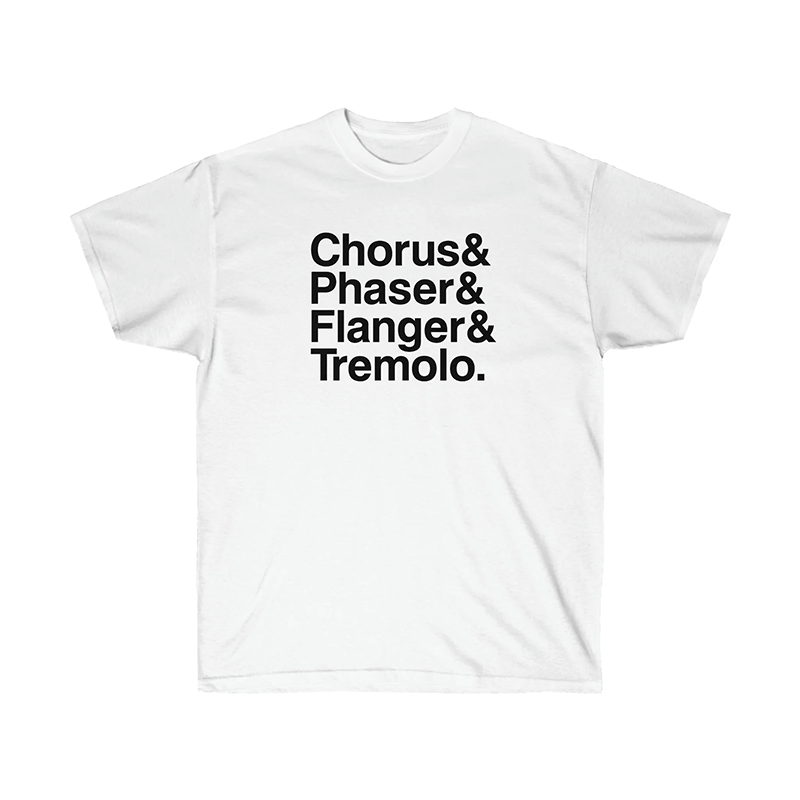One of the first pedals we ever reviewed here at Pedal of the Day was from our friends at Catalinbread (the Semaphore Tremolo) and we’ve been marveling at every new release they’ve had since then. Today, we’re proud and honored to help introduce the world to the Tribute Parametric Overdrive, a 4-knob, amp-driving, tone-shaping powerhouse that’s sure to find its way onto pedalboards across the globe. Let’s see what they have to say about this golden beauty, shall we?
Overview
Ahoy ahoy, you’ve just accessed the lore of the Tribute, a pedal that literally every guitarist needs. Yes, even you, outlaw country fan, and you, person wearing indecipherable metal logo band shirt. You see, the Tribute is an all-analog circuit that combines an extremely expressive high-headroom drive engine with an obscenely powerful and flexible tone control. The back end of the Tribute pays—ahem—homage to one of our oldest designs, the VariOboost. This circuit gives you a supercharged one-band parametric EQ in lieu of a tone control for some serious studio-esque tone sculpting power. Playing rhythm? Dial in a low-mids grunt and boost that band for some fat chords. Playing leads? Flip that thing and inject some sparkle into your sound. Want to fake a cocked wah pedal to nail your cover of “Money for Nothing”? Want to simulate some Peter Green-esque out-of-phase pickups? Want your single-coils to sound like humbuckers? What about the other way around? Sure, why not? Want all of that and more? It’s time to play Tribute.
Controls
Volume: You like it loud? Good thing! The Volume control gives you plenty of the good stuff.
Drive: The core of the Tribute is an exacting buffer followed by a drive circuit that is governed by a dual-gang potentiometer. Wait, what? All this means is that turning the Drive knob affects two parameters at once instead of just one. In the Tribute, those two controls are clean blend and overdrive gain. When Drive is rolled all the way down, you get your pristinely buffered clean signal with a gentle treble filter. When it’s all the way up, maximum gain is achieved with no clean signal present. Anywhere in between gives you a carefully balanced clean-drive combo that lets your tone breathe at all positions.
Freq: This control is part of the original VariOboost circuit, and Freq and Tone work in tandem. Freq selects a frequency between 70Hz and 1.4KHz, which is then cut or boosted by the Tone control. See diagram below if this makes no sense right now.
Tone: After dialing in the Freq[uency], use this control to boost or cut the selected frequency by 12dB. This control is equipped with a center-detent potentiometer; just click it to noon and the frequency is flat; this means that nothing is boosted or cut regardless of Freq position. Clicking the Tone knob to noon effectively removes the VariOboost component.
Nuts & Bolts:
A Hertz, abbreviated Hz, is the unit of measurement of frequency, which is how your ear perceives sound. One Hertz is equivalent to one cycle (or “event”) per second. Want to make a 1Hz oscillator (signal generator) right now? Bang your fist on the nearest surface once per second. Want to make a 2Hz oscillator? Do it twice as fast. You see where this is going. If you can somehow beat your fist on your table 100 times per second, you would generate a tone whose frequency is 100Hz. Guitar strings vibrate when you play them, and they vibrate a certain amount of times per second. For simplicity’s sake, your pickups “pick up” these frequencies, and then your amp amplifies them. A guitar tuned to standard generates 80Hz from an open low E, and up to whatever the fretboard allows on the high E. Whatever you add after that is between you and the amp. Most electrical music gear splits the frequency range into three makeshift “bands,” bass, middle and treble, each with their specified range of Hertz. For those of you unaccustomed to thinking about sound in this way, we’ve created a simple chart to explain how you might apply these numbers in players terms:
70-100Hz: Sub bass. Boost this section to bring out some tones that are more felt than heard. Cutting this band is guaranteed to incite far fewer arguments with your bass player. In standard tuning, your low E fundamental lives here at 82Hz. Downtuned guitars love this frequency; a low C# fundamental is close to 70Hz.
100-250Hz: Bottom end, also known as “grunt”. Increase this to add some low-end push, fatten up some thin pickups, give a little extra push to stubborn amps or bring some overall weight to your tone. Cut this to keep your guitar tight in the mix, or if you’re playing leads. Your A, D, G, and B fundamentals live here (110Hz, 147Hz, 196Hz, 247Hz, respectively).
250-500Hz: Low mids, also known as “warmth”. Bring this up to, as we say, “warm up” your tone. Some careful adjustments to this band will lead to some truly amazing rhythm tones. Cutting this band, sometimes called the “mud band,” provides a bit of harmony within a crowded mix. For reference, your high E fundamental lives here at 330Hz.
500Hz-1KHz: Mids, also known as “body.” Boosting this band lets you really stand out in even the densest mixes with multiple instruments. If you’re playing in a band that occupies one of the many subgenres of metal, this is likely where you’d “scoop the mids,” or make them quiet relative to the surrounding frequencies. Quite frankly, if you’re in a death metal band, the Tribute just became your new best friend. Faking a different pickup type usually involves some careful adjustment in this region; boost to turn single coils into humbuckers, cut for the opposite.
1-1.4KHz: High mids and treble, also known as “presence”. If you’re feeling saucy, boosting this band augments your solos because it amplifies the frequency band in which your pick attack lives. This is also where some harshness can live so adjust sparingly. Slightly cutting here can shave a little top end from your sound if you’re playing with other instruments that normally occupy this space. Deeper cuts can simulate out-of-phase pickups (in the middle position) for a somewhat hollow, but very unique tone.
What seems like a perhaps simple overdrive unit with four knobs is actually a complex, genre-spanning, thought-invoking and experimental pedal that’s guaranteed to thrill your soul. Utilizing powerful technology and precise original circuitry, the Tribute Parametric Overdrive is a stand-out effect that was an absolute monster from the moment we plugged it in. You’re going to need to hear it in action, of course, to get the full effect, and what better place to start than with our demo video below? Cheers to Catalinbread on another sonic marvel – be sure to head to their website for more pedals, info and ordering, cheers!!
Affiliate Links:
Sweetwater – https://sweetwater.sjv.io/MX05KP
StewMac – https://stewmac.sjv.io/P0X7BQ
Perfect Circuit – https://bit.ly/3pHpS6P
Amazon – https://amzn.to/3FN04Mq
GET EXCLUSIVE UPDATES, CONTEST INFO, SEE OUR LATEST DEMO VIDEOS AND MORE:


















